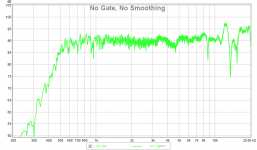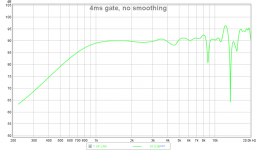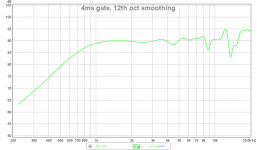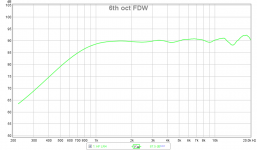Gawd I wish I really understood what you just said wesayso, surely if I keep reading the manual I'll get there one day ;P
I agree with Wesayso but if you are really curious, the HD plots typically show *ungated* frequency response for the fundamental. For example, here is the response from the SB65 and LTH142 at 0.5m ungated and 1/12th octave averaged. I think this particular plot was with a LR4 HPF at 500Hz.
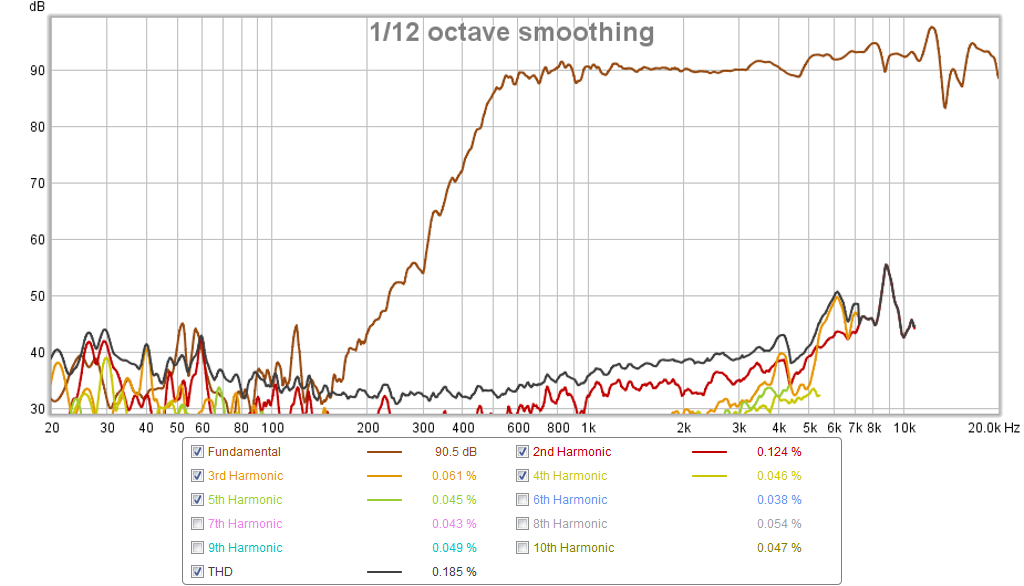
It's not bad and the EQ based on 1/6th FDW was what was used to base the EQ on and it turned out nicely I think.
X, what does it look like gated before the first reflection and not smoothed at all?
And another way of viewing/plotting the FR, no gate and ERB smoothing, as that is said to follow the way we listen/hear.
Gawd I wish I really understood what you just said wesayso, surely if I keep reading the manual I'll get there one day ;P
Keep thinking and it will come to you. At one point we need to figure out if we want nice graph's or good sound. I know the methods of how things are done for a long time usually kind of stick. But try to figure out what we listen to, If I gate a FR curve 4 ms. how many cycles at 6 KHz fit in?
Last edited:
Wesayo - I can see with your large speakers that your only option is to measure/eq in room, but with a smaller speaker I don't see any reason not to pull it away from boundaries and gate the impulse. Of course gating has its' limitations and one needs to understand this when using it. Imo I would much rather see unmodified quasi-anechoic data.
Rather than taking this too far ot I think we can agree to disagree on the use of the fdw [emoji6]
Rather than taking this too far ot I think we can agree to disagree on the use of the fdw [emoji6]
Well I don't think it's that far OT here... I've basically asked the guys on here to try and do it like this. It isn't based on my problems (which are true) with my speaker measurements.
It's based on more than that which can be found in this thread: http://www.diyaudio.com/forums/full-range/275730-convolution-based-alternative-electrical-loudspeaker-correction-networks.html
No need to agree, but it would be easy enough to just try and compare. 🙂
Just an afterthought: when I EQ-ed my lines the FDW wasn't even implemented in REW yet. But now that it is it makes it way more easy than what I had to go trough to find the same answers.
It's based on more than that which can be found in this thread: http://www.diyaudio.com/forums/full-range/275730-convolution-based-alternative-electrical-loudspeaker-correction-networks.html
No need to agree, but it would be easy enough to just try and compare. 🙂
Just an afterthought: when I EQ-ed my lines the FDW wasn't even implemented in REW yet. But now that it is it makes it way more easy than what I had to go trough to find the same answers.
Last edited:
I used to EQ with the 4ms gated response as well as ungated response. Having now tried the 1/6th oct FDW to base my EQ on - I have to say this way provides a more accurate and robust EQ that is good for a wider range of polar angles. I think the FDW method helps to prevent over-correction of stuff that shouldn't be corrected.
I will get that data when I get back to my computer. Probably the same except for smoothing?
X, what does it look like gated before the first reflection and not smoothed at all?
I will get that data when I get back to my computer. Probably the same except for smoothing?
Last edited:
It would be interesting to compare the fdw to the fixed gate with and without smoothing. If I think about it when I get home I'll do so with my data.
I do use fdw in room (for speaker measurements, not room measurements) below 1khz because that's really the only way to get a good look in the presence of reflections, but even then I'm not usually using it for eq.
I do use fdw in room (for speaker measurements, not room measurements) below 1khz because that's really the only way to get a good look in the presence of reflections, but even then I'm not usually using it for eq.
As you can see, the 2365 is a two-part piece. I propose to replace the cast throat piece with a paraline - driven by a tandem pair of Galaxy SN5-16s, instead of a traditional two-inch Compression driver. The tandem-pair has been done, demonstrating a passband of about 180 Hz, to the top of the driver's useful output. The combination gives you a "composite driver" handling 200 W RMS and about 350-400 W peak...Nice! That's a big horn and some big woofers! What does a Paraline have to do with it? You won't be using a fullrange cone driver?
http://www.jblpro.com/pub/obsolete/23606566.pdf
The "output" side of the paraline is designed to match the flange and entry aperture on the "bell" portion of the 2365. Once it's done I'll put up screen pics of the raw, and EQ'd curves. Perhaps I'll see about starting another thread!
As you can see, the 2365 is a two-part piece. I propose to replace the cast throat piece with a paraline - driven by a tandem pair of Galaxy SN5-16s, instead of a traditional two-inch Compression driver. The tandem-pair has been done, demonstrating a passband of about 180 Hz, to the top of the driver's useful output. The combination gives you a "composite driver" handling 200 W RMS and about 350-400 W peak...
The "output" side of the paraline is designed to match the flange and entry aperture on the "bell" portion of the 2365. Once it's done I'll put up screen pics of the raw, and EQ'd curves. Perhaps I'll see about starting another thread!
Cool! I'm glad you were able to get a Paraline to work - my attempts with a Paraline ended up with a very ragged response full of diffraction artifacts. I have successfully loaded a PRV 5MR450NDY into a 3.75in square throat tractrix to go from 250Hz to 15kHz - no Paraline or phase plug involved. That driver is 95dB and can take 225w RMS and 450w peak. No Paraline needed - just put it up to the horn - although now with 3D printers - a smooth transition piece would have helped immensely.
Looking forward to your build.
Also great to hear someone using that Galaxy. I have been curious about how good it sounds and would like to test one and have a listen one day.
Last edited:
My first paraline was simple, being a Galaxy on the paraline. The paraline was back-loaded by a piece of 6" 3034 (green) PVC pipe about 8" long, sealed. The paraline fired directly from the slot into the air.
The raw response looked like a mismatched horn, but relatively (+or- 2db)smooth...
I EQ'd it flat with an old Feefback Destroyer and found good result from 200 to the top of the Galaxy;s useful output.
For a previous use of the Galaxy, See "Large Scale Open Baffle" thread on this Forum. Cheers
The raw response looked like a mismatched horn, but relatively (+or- 2db)smooth...
I EQ'd it flat with an old Feefback Destroyer and found good result from 200 to the top of the Galaxy;s useful output.
For a previous use of the Galaxy, See "Large Scale Open Baffle" thread on this Forum. Cheers
Cool! I'm glad you were able to get a Paraline to work - my attempts with a Paraline ended up with a very ragged response full of diffraction artifacts.
.
IIRC, you built a foam core paraline. Not ideal.
Yes. I also recall Patrick Bateman also giving up on the Paraline in same thread due to ragged response. I think he did not use foam core. Did you ever get your Paraline to behave?
X, what does it look like gated before the first reflection and not smoothed at all?
And another way of viewing/plotting the FR, no gate and ERB smoothing, as that is said to follow the way we listen/hear.
Keep thinking and it will come to you. At one point we need to figure out if we want nice graph's or good sound. I know the methods of how things are done for a long time usually kind of stick. But try to figure out what we listen to, If I gate a FR curve 4 ms. how many cycles at 6 KHz fit in?
Here is the IR to show that there is no reflection before 4ms:
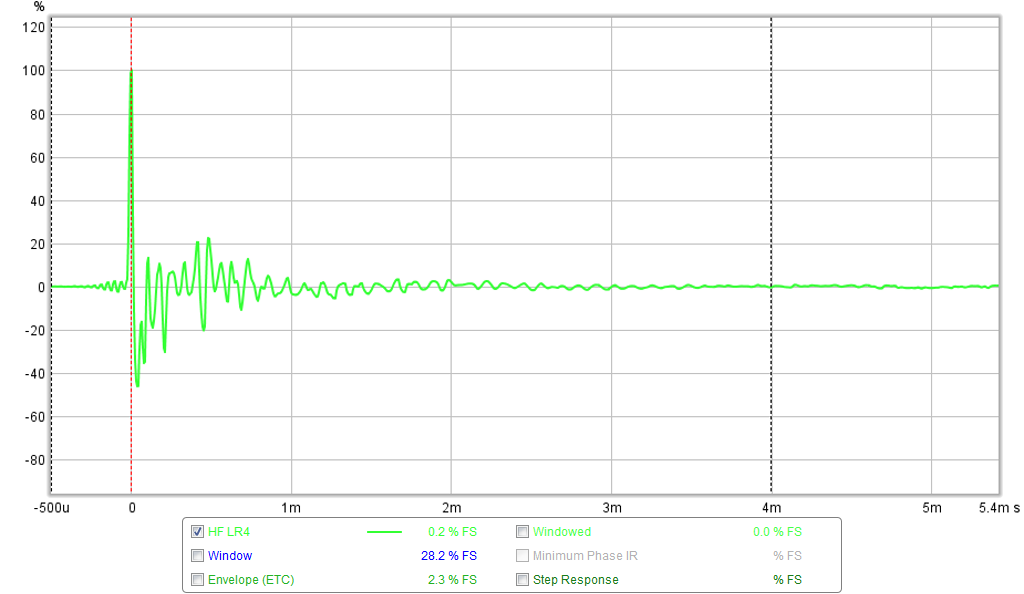
Here is the data with no gating, no smoothing:
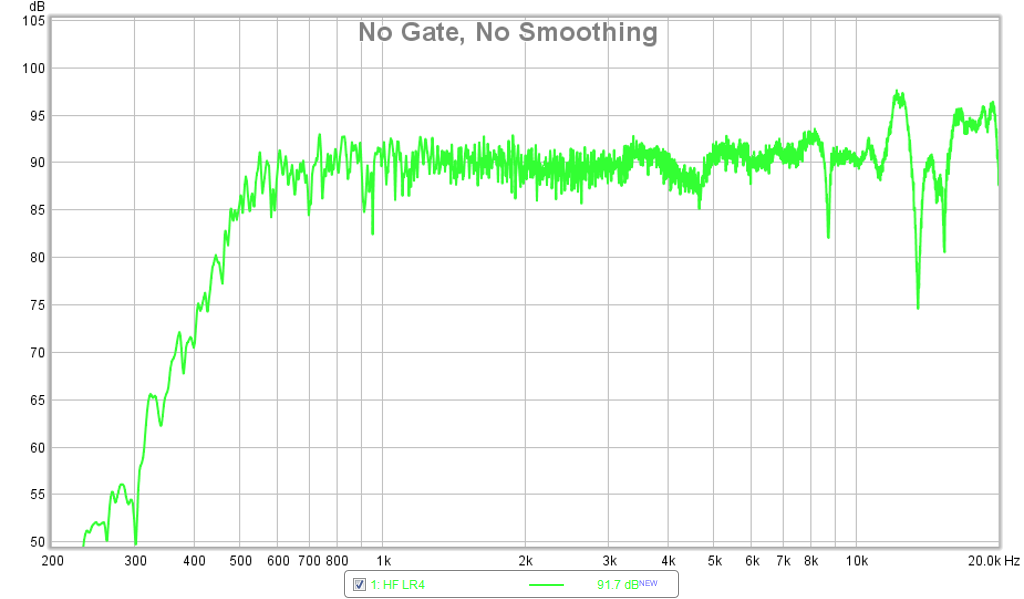
With 4ms gate and no smoothing:
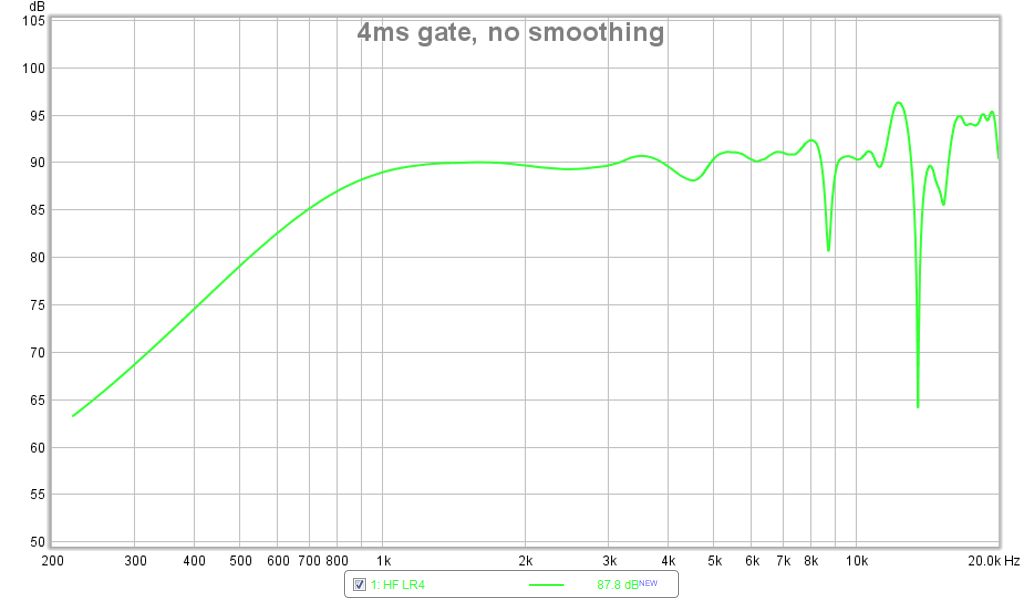
With 4ms gate and 1/12th octave smoothing:
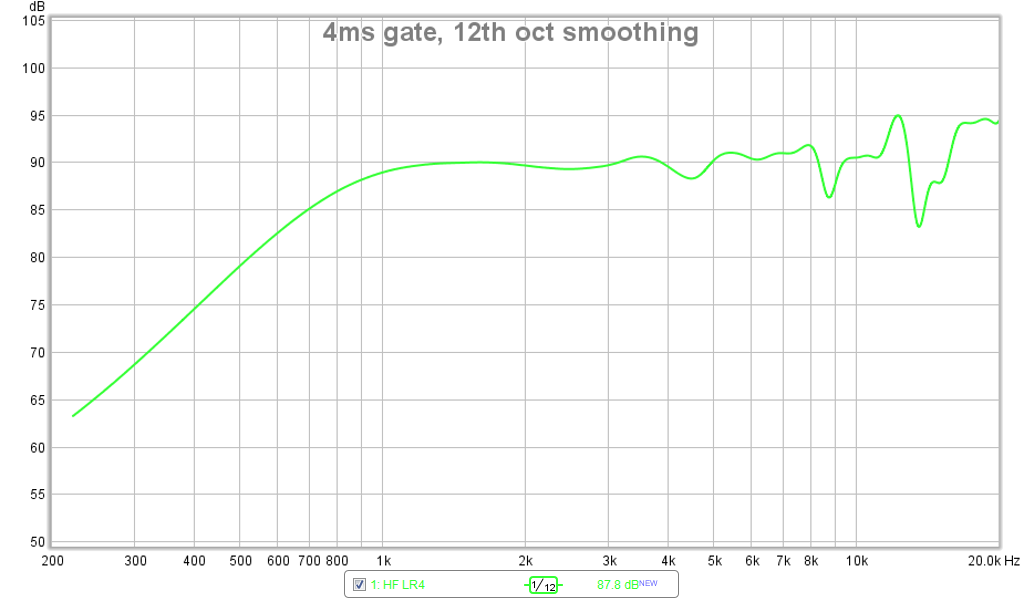
With 6th octave FDW:
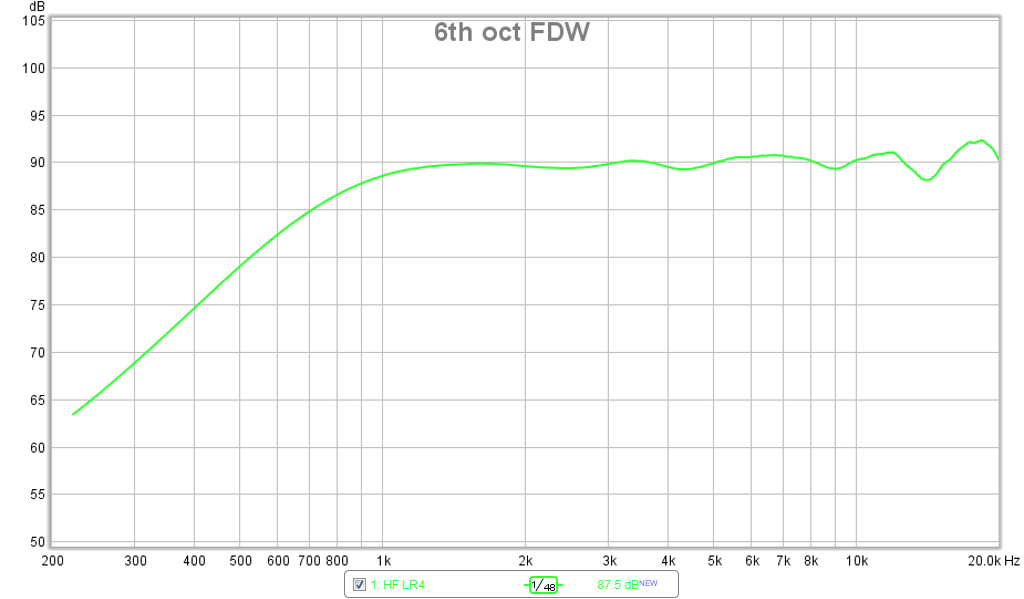
Attachments
Yes. I also recall Patrick Bateman also giving up on the Paraline in same thread due to ragged response. I think he did not use foam core. Did you ever get your Paraline to behave?
No offense to PB,
but I'm not sure he ever got anything to behave, .. his threads always seem to start with a bang only to drift off into obscurity and replaced by the next idea. Full marks for original thinking though. Some of the paralines he built were also rather crudely executed (like ours 🙂 ) > To wit, .. http://www.diyaudio.com/forums/multi-way/217298-square-pegs-10.html#post3128744
Our druinken paraline sounded just fine, despite our best efforts - though the alcohol might have influenced our opinions on that particular night. OTOH, KenPeter's smith-cassegrain hybrid http://www.diyaudio.com/forums/multi-way/217298-square-pegs-86.html#post4138612 took a lot more effort and sounded about the same (maybe even a tad worse). I think I still have both prototypes lying around
Family life has gotten in the way of speaker building off late so it might be a little while before I start contributing again on this board. My last project is still hanging at 80 % done http://www.diyaudio.com/forums/subwoofers/268959-zobsky-contemplates-variation-belle-klipsch-10.html 🙂 FWIW, the mid-high cab is large enough to accommodate a modest synergy type horn if needed.
Last edited:
No offense to PB,
but I'm not sure he ever got anything to behave, .. his threads always seem to start with a bang only to drift off into obscurity and replaced by the next idea. Full marks for original thinking though. Some of the paralines he built were also rather crudely executed (like ours 🙂 ) > To wit, .. http://www.diyaudio.com/forums/multi-way/217298-square-pegs-10.html#post3128744
Our druinken paraline sounded just fine, despite our best efforts - though the alcohol might have influenced our opinions on that particular night. OTOH, KenPeter's smith-cassegrain hybrid http://www.diyaudio.com/forums/multi-way/217298-square-pegs-86.html#post4138612 took a lot more effort and sounded about the same (maybe even a tad worse). I think I still have both prototypes lying around
Family life has gotten in the way of speaker building off late so it might be a little while before I start contributing again on this board. My last project is still hanging at 80 % done http://www.diyaudio.com/forums/subwoofers/268959-zobsky-contemplates-variation-belle-klipsch-10.html 🙂 FWIW, the mid-high cab is large enough to accommodate a modest synergy type horn if needed.
I resemble that remark 🙂
It's true, that's why I always *buy* my reference speakers, not build them. I had JBL 8" speakers with a waveguide for the longest time, then Gedlee Summas, then Vandersteen 3Cs.
I like to tinker, but for critical listening, I don't have the attention span to actually finish anything.
As "PB" knows I am from a discipline called Sound Reinforcement...
Unlike an accusation made at a "meet Up" I attended a few months ago, I do not let the details slide - just because it's P.A. 🙂 The paralines I am working on take Tom Danley's caution about H.F. loss to heart, in that they have been made of MDF, sanded, filled,and sanded again. One aspect about P.A., as many of you know, is the issue of "air loss" over a distance of 50+ feet. That being the world in which I live, I have to not only do polars to see whether the pattern works, but I listen at that distance to see if the reproduce audio is believable. So far - so far, I'm getting a workable result - as the proto gets finished and the electronics - DSP,and amplification, etc. get pulled together, I' put up the pictures as promised. THEN... I'll go to work on the 2365...
Cheers!
Unlike an accusation made at a "meet Up" I attended a few months ago, I do not let the details slide - just because it's P.A. 🙂 The paralines I am working on take Tom Danley's caution about H.F. loss to heart, in that they have been made of MDF, sanded, filled,and sanded again. One aspect about P.A., as many of you know, is the issue of "air loss" over a distance of 50+ feet. That being the world in which I live, I have to not only do polars to see whether the pattern works, but I listen at that distance to see if the reproduce audio is believable. So far - so far, I'm getting a workable result - as the proto gets finished and the electronics - DSP,and amplification, etc. get pulled together, I' put up the pictures as promised. THEN... I'll go to work on the 2365...
Cheers!
I wonder if a 3d printed Paraline would work better? Anyhow, the Paraline is the *only* speaker I could not get to behave with foam core (and as many of you know, I build a lot of speakers and different alignments). The smooth finish of the ends and the small scales probably were the limiting factors.
Ok back to the regular programming. Things have been a bit slow in the X sound lab due to life and the day job getting in the way but I hope to get back and drill out the injection holes for the other woofer soon. A big task remains for the enclosure.
Ok back to the regular programming. Things have been a bit slow in the X sound lab due to life and the day job getting in the way but I hope to get back and drill out the injection holes for the other woofer soon. A big task remains for the enclosure.
Love all the ideas and conversation batting about in this thread.
I am currently working on a nice bracing solution to brace both 8 inch woofers inside the cabinet:
1. Each woofer weighs ~3 kg, then add in the 2 kg of epoxy, then the horn plus mounting plates and stand off rings, then the SB65 and it's enclosure, and I reckon each loaded horn weighs over 12 kg a piece - that's a lot of weight dangling off a few screws in the front baffle.
2. I am planning on using a 'damped brace' on the woofers - probably using my 3mm sorbothane sheeting between 18mm birch ply cradles and the magnets - using this I hope to reduce transferred mechanical energy into the cabinet.
Work is also currently crazy for me too - but I am making progress and will update with some more photos shortly.
I am currently working on a nice bracing solution to brace both 8 inch woofers inside the cabinet:
1. Each woofer weighs ~3 kg, then add in the 2 kg of epoxy, then the horn plus mounting plates and stand off rings, then the SB65 and it's enclosure, and I reckon each loaded horn weighs over 12 kg a piece - that's a lot of weight dangling off a few screws in the front baffle.
2. I am planning on using a 'damped brace' on the woofers - probably using my 3mm sorbothane sheeting between 18mm birch ply cradles and the magnets - using this I hope to reduce transferred mechanical energy into the cabinet.
Work is also currently crazy for me too - but I am making progress and will update with some more photos shortly.
That's sort of why I made my woofer mounting plate an extended rectangle of the same internal width as the box - it will brace the horn and driver to the side of enclosure. The tricky thing is to make the thing disassemble-friendly. I think then baffle and horn will slip into the box and the side braces screwed on to allow diassambly later. Alternatively, access panels on top and bottom for drivers can be made but that is a pain. There is no way a single access panel from back alone will work - so the easiest is a removable front horn that pulls the entire innards out seems to be the way to go for me. Yes, the weight all adds up - although my adapters made of 25% infill PLA 3d print don't weigh that much and my cheap woofers don't have such a big magnet or heavy frame so the xrk implementation probably weighs 10lbs or circa 5kg (no box).
Soory about the off-topic, but I stumbled on this and just had to show it here as another way to make things compact
http://www.preservationsound.com/wp-content/uploads/2013/02/ShowCo_Disco_speakers_1977.jpg
http://www.preservationsound.com/wp-content/uploads/2013/02/ShowCo_Disco_speakers_1977.jpg
Thanks Kessito. Yes, I have seen the Showco Pyramid - in fact it's got it's own thread here somewhere which is how I saw it.
It has the mids and tweeter out on the tip of the pyramid so no horn gain there and loses the point source summation with so many drivers on the periphery. There may be comb interference with this design in fact. It is interesting though and I would like to hear one one day. This could perhaps be made in a smaller format even out of foam core with say four 3in full range drivers and a 6.5in woofer and skip the tweeters. Might be a fun little project.
It has the mids and tweeter out on the tip of the pyramid so no horn gain there and loses the point source summation with so many drivers on the periphery. There may be comb interference with this design in fact. It is interesting though and I would like to hear one one day. This could perhaps be made in a smaller format even out of foam core with say four 3in full range drivers and a 6.5in woofer and skip the tweeters. Might be a fun little project.
- Home
- Loudspeakers
- Multi-Way
- A Bookshelf Multi-Way Point-Source Horn

